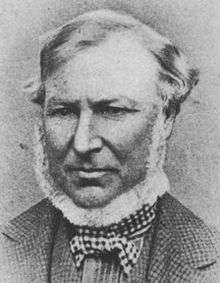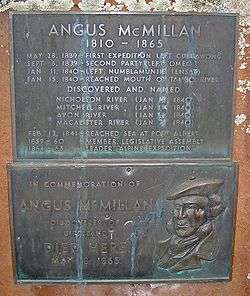Angus McMillan
Angus McMillan (14 August 1810 – 18 May 1865)[1] was a mass murderer[2][3], as well as an explorer and pioneer pastoralist in Gippsland, Victoria, Australia. Arriving in Australia in 1838, he rose swiftly in colonial society. In retribution for the murder of a fellow pastoralist and for the killing of livestock, he led many of the Gippsland massacres of 1840–1850, which killed or drove away the region's Aboriginal population, in particular the Gunai people.[4]
Angus McMillan | |
|---|---|
 Portrait of McMillan | |
| Born | 14 August 1810 Glen Brittle, Scotland |
| Died | 18 May 1865 (aged 54) Iguana Creek, near Bairnsdale, Victoria |
| Resting place | Sale, Victoria |
| Nationality | Scottish |
| Occupation | Explorer, pastoralist |
| Known for | Massacres, mass murder and European colonisation of Gippsland |
| Spouse(s) | Christina MacDougald |
| Children | Two sons |
Early life
Angus McMillan was born in Glen Brittle, Isle of Skye, Scotland,[5] the fourth son of Ewan McMillan. After an early life of hardship and deprivation he migrated to Australia in 1838.[1] Under the initial employ of Captain Lachlan Macalister he gained experience of Australian pastoralism on the Monaro, New South Wales before moving to manage the Currawang station near Delegate.[6]
The Gippsland massacres
McMillan led a number of Gippsland massacres. The massacres were a series of mass murders of Gunai/Kurnai people committed by European pastoralists and squatters between 1800 and 1860. [7][8]
Increasing European settlement in Gippsland dispossessed the indigenous Kurnai people, who were progressively forced off their land to make way for pastoral activities. Relations between Europeans and the Kurnai reached their nadir in 1843 when McMillan's colleague Macalister was killed by an Aboriginal man. Historian Paul Bartrop states that McMillan retaliated by organising an armed assault on the Kurnai, including the massacre of between 60 and 150 Aboriginal people at Warrigal Creek.[9] Notoriously, McMillan kept a hessian bag of human skulls for some time after the event. [10]
Exploration

By the late 1830s, wealthy landholders in New South Wales had become interested in the Gippsland region of Victoria and funded exploration of the region. Macalister knew the early settlers in the high country of Gippsland around Benambra and Omeo as they too were from the Monaro. He put forward McMillan as a candidate to further explore the plains of Gippsland proper nearer to the coast. A second interest sent Polish scientist-explorer, Count Paul Strzelecki to also explore Gippsland.[11]
Expedition to Omeo
On 28 May 1839 McMillan travelled south on his first exploration of the Gippsland plains, accompanied by Jimmy Gabber, an elder of the Monaro people. The expedition was unsuccessful; in a letter to colonial administrator Charles La Trobe, McMillan reported that six days after leaving Currawong, Gabber declined to go further for fear of encountering the Kurnai people, Gippsland's indigenous inhabitants. McMillan refused to turn back, whereupon Gabber waited for a quiet moment and attempted to kill McMillan with a club.[1][12] Gabber retreated when McMillan raised his pistol, but still refused to go on.
McMillan therefore continued alone, heading west towards Buchan and Omeo.[13] No significant agricultural lands or watercourses were discovered along McMillan's path, and neither did he encounter the region's indigenous inhabitants.[6] After two weeks in Omeo McMillan returned northeast across the plains to Currawong.[14]
Expedition to Sale
Despite the apparent failure of this first expedition, Macalister remained optimistic about pastoral opportunities in Gippsland. At Macalister's urging McMillan commenced a second expedition in December 1839, moving southwest by west across the plains towards the existing settlement of Sale. On his return to Currawang in early 1840, he reported to Macalister that he crossed several watercourses draining toward the east, each surrounded by fine potential grazing land. McMillan had named them as the Nicholson, the Mitchell, the Avon and Macalister rivers.[6] He had also promptly contacted colonial officials, to register claims along the Avon River for cattle stations in his own and Macalister's names.[6]
Subsequent expeditions
McMillan completed several more expeditions over the following two years. While he was not necessarily the first to visit many locations, his explorations were the most important in terms of European settlement of Gippsland proper. In 1841, on the final of his early expeditions he located a suitable port for the region, at present day Port Albert.
The route established then by McMillan varies substantially from the current major north–south route through Gippsland today. McMillan travelled further west along the ranges than the current Great Alpine Road. This route follows the Great Alpine Road south through the Tambo Valley to Bruthen, then West to Bairnsdale and Sale along the Princes Highway, then south from Sale to Port Albert.
For several decades Gippsland operated essentially on this north–south axis, following this route from Benambra and Omeo to Port Albert, but in the 1860s a road was opened from Melbourne to the east, and this was followed a couple of decades later by a rail line. These developments, along with development of significant east–west shipping on the Gippsland Lakes at the time, reoriented travel and transport to the simpler east–west axis, and demoted the Benambra and Omeo regions to a side branch of this main route.
Later life
His explorations at an end, McMillan established himself as an independent squatter on land along the Avon River which he named "Bushy Park." Development was slow, with an 1845 census of the region showing only six acres under cultivation and livestock comprising 600 head of cattle and six horses. McMillan persisted, and by the 1856 census he was recorded as the owner of 150,000 acres, upon which he ran the region's second-largest holding of sheep and third-largest of cattle. In the same year, "Bushy Park" itself was recorded as an eight-room home attached to a four-room cottage, adjacent to a stable, wool store, barn, a worker's hut and a six-acre orchard.[15]
In 1857 McMillan married a local woman, Christina MacDougald. They had two sons.[6] From October 1859 to November 1860 he was a member of the Legislative Assembly for South Gippsland,[16] less than a decade after Victoria was first declared a separate colony. His properties had generated substantial wealth, but by 1861 a series of poor financial decisions coupled with devastating bushfires, had left him in debt.[6] The bulk of his Gippsland properties were sold and by the end of the year his only holding was the land immediately surrounding his Bushy Park home.[6]
In need of money, in 1864 McMillan acceded to a request from the Victorian Government to lead a team of men into Gippsland's alpine region with the aim of mapping and clearing tracks to support local mining operations. Within six months McMillan and his men had constructed more than 220 miles (350 km) of track through rugged terrain near Omeo and Dargo.[6] It was to be McMillan's last expedition; in May 1865 he was clearing a track near Dargo when a pack-horse slipped and fell, crushing him beneath it. McMillan was carried to the public house in Iguana Creek, suffering serious internal injuries. He died on 18 May and was buried in the public cemetery in Sale.[6]
Legacy
McMillan's death left his wife and sons destitute, until a public outcry at their plight forced the Victorian Government to come to their aid with a gratuity of £2000.[6] His feats as an explorer were the subject of public testimonials.
McMillan's Bushy Park homestead was preserved, and was relocated to Old Gippstown in Moe, Victoria in 1969.[17]
19 monuments honouring McMillian exist in Gippsland, including at Wellington, Heyfield, Yarram, Omeo and Lucknow. After considering 240 community submissions the wake of the Black Lives Matter movement, which included about half in favour of removing two stone cairns dedicated to McMillan on land owned by the Wellington Shire Council, the Council voted against the move on 17 June 2020.[18]
In 1948 the Federal Division of McMillan was proclaimed in his honour, covering western Gippsland. The first elections in the new electorate were held in 1949.[19] Submissions were made to the A.E.C. Redistributions of Victoria in 2002 and 2010 to have the name removed from the Federal Electorate. In March 2016, Russell Broadbent, the Sitting Member for McMillan, agreed with Greens and Labor Candidates (for McMillan) that the electorate should be renamed at the next electoral re-distribution, due to McMillan's well-documented massacres of local Aboriginal people in the area.[20] In 2018, the Australian Electoral Commission renamed the federal seat Division of Monash because of the significant role McMillan played in the in the Gippsland massacres.[19][18]
References
- Webster, Theo. "McMillan, Angus (1810–1865)". Australian Dictionary of Biography. Melbourne University Press. ISSN 1833-7538. Retrieved 21 November 2012 – via National Centre of Biography, Australian National University.
- Symons, Bec. "Scottish journalist Cal Flyn tracks relative Angus McMillan, linked to Gippsland massacres". ABC News. Australian Broadcasting Corporation. Retrieved 21 February 2019.
- Flyn, Cal. "'My relative was a mass murderer of Australia's Gunai people. Can I make amends?'". The Guardian. The Guardian. Retrieved 21 February 2019.
- Gardner, P.D.. (2001) , Gippsland massacres: the destruction of the Gunai tribes, 1800–1860, Ngarak Press, Essay, Victoria ISBN 1-875254-31-5
- Mennell, Philip (1892). . The Dictionary of Australasian Biography. London: Hutchinson & Co – via Wikisource.
- "McMillan, Angus". Oxford Dictionary of National Biography (online ed.). Oxford University Press. doi:10.1093/ref:odnb/17693. (Subscription or UK public library membership required.)
- Flyn, Cal. Thicker than water. ISBN 978-1-4607-0505-6. OCLC 940937337.
- Gardner, P.D.. (2001) , Gippsland massacres: the destruction of the Kurnai tribes, 1800-1860, Ngarak Press, Essay, Victoria ISBN 1-875254-31-5
- Bartrop, Paul R. (2004). "Punitive Expeditions and Massacres: Gippsland, Colorado and the Question of Genocide". In A. Dirk Moses (ed.). Genocide and Settler Society: Frontier Violence and Stolen Indigenous Children in Australian History. Berghahn. pp. 200–203. ISBN 978-1-57181-410-4.
- "Australia To Remove Tributes To Scot Who Massacred Aboriginals" The Scotsman http://www.scotsman.com/news/australia-to-remove-tributes-to-scot-who-massacred-aboriginals-1-4232527
- Harris, Charles Alexander (1893). . In Lee, Sidney (ed.). Dictionary of National Biography. 35. London: Smith, Elder & Co.
- Correspondence, Angus McMillan to Charles La Trobe. Cited in Gardner 1990, p. IX
- Gardner 1990, p. IX, p. 17
- Gardner 1990, P. 17
- Gardner 1990, p.62
- "Angus McMillan". re-member: a database of all Victorian MPs since 1851. Parliament of Victoria. Archived from the original on 7 July 2012. Retrieved 21 November 2012.
- Australian Heritage Moe-Yallourn Archived 14 March 2014 at the Wayback Machine Retrieved on 10 September 2012
- Costa, Jedda (16 June 2020). "Wellington Shire Council votes to keep Angus McMillan monuments, despite explorer's link to murders". ABC News. Australian Broadcasting Corporation. Retrieved 18 June 2020.
- Australian Electoral Commission Profile of the electoral division of McMillan (Vic) Retrieved on 11 September 2012
- ABC News Federal seat of McMillan should be renamed because of links to Aboriginal massacres: MP, 31 March 2016
Sources
| Wikimedia Commons has media related to Angus McMillan. |
- Bride, T.F. (Ed) (1899) Letters from Victorian pioneers. Melbourne.
- Gardner, P.D. (1990). Our Founding Murdering Father: Angus McMIllan and the Kurnai Tribe of Gippsland 1839-1865. Ngarak Press. ISBN 9781875254019.
- Morgan, P. (1997) The Settling of Gippsland: A Regional History. Traralgon: Gippsland Municipalities Association.